| BEFORE II W.W. | II W.W.
|
AFTER II W.W. |
| UPDATED MAR 2024 | ME - CONTACT |
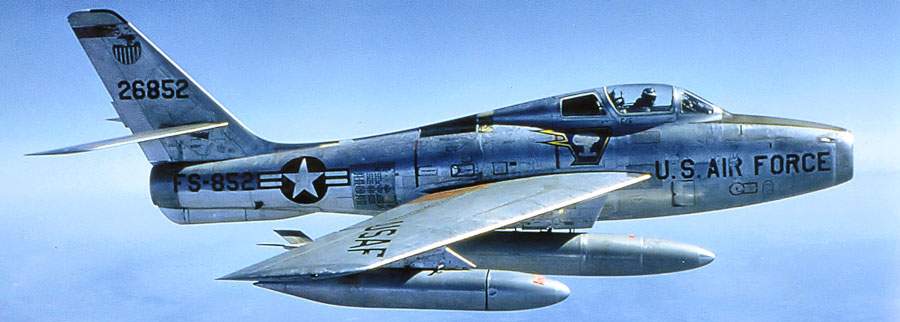 |
|
REPUBLIC F-84-F THUNDERSTREAKBREITLING USAF TYPE A-10A |
|
 |
|
| |
|
 |
THE CLOCKThe Breitling 640-12 chronograph, meeting all the numerous requirements of the USAF, was designated Type A-10A.
It has 16 jewels and an 8-day power reserve. The movement and case are the same, the only difference is the engraving on the dial.
I imagine that the watch was designed to meet the requirements of the USAF, and then it was also sold to the civilian industry. |
 |
|
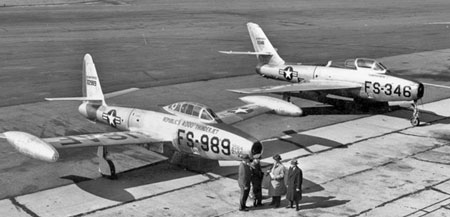 |
THE PLANEOriginally intended to be a relatively simple upgrade to the F-84 Thunderjet to make it more competitive with the F-86 Sabre, differing largely in the use of a swept-wing and tail. See image at the left.
The engine was upgraded to the much more powerful British Armstrong Siddeley Sapphire built in the United States as the Wright J65. The larger engine required the fuselage to be stretched into an oval shape and the air intake to be modified.
Finally entered service in November 1954, by which time the Sabre had also undergone many upgrades and the Thunderstreak was relegated to the fighter-bomber role. Its time as a front-line design was brief, it began to be moved to secondary roles as early as 1958.
2,711 were built, 1,301 went to NATO under Mutual Defense Assistance Program (MDAP), and other allies, who took them up in large numbers. Operators included the Belgium, Denmark, France, Germany, Norway, Grece, China etc.
The Thunderstreak suffered from the same poor takeoff performance as the straight-wing Thunderjet despite having a more powerful engine. it also suffered from accelerated stall pitch-up and potential resulting separation of wings from the airplane. In addition, spins in the F-84F were practically unrecoverable and ejection was the only recourse below 10,000 feet (3,000 m).
F-84-F was in service in the Tactical Air Command aircraft were equipped with Low-Altitude Bombing System (LABS) for delivering nuclear bombs.
The F-84 was the first aircraft flown by the United States Air Force Thunderbirds, which operated the F-84G Thunderjets from 1953 to 1955 and the F-84F Thunderstreaks from 1955 to 1956. |
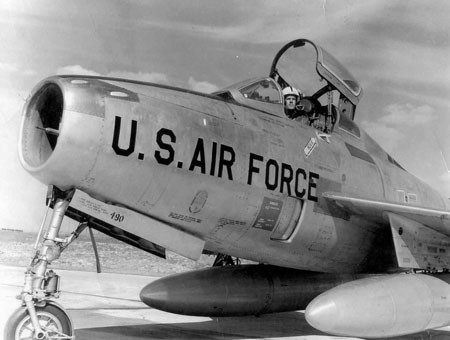 |
|
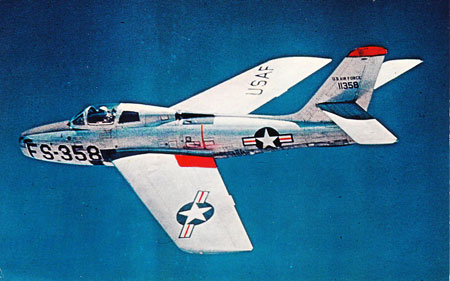 |
|
 |
|
F-84 A INCREDIBLE TEST BED
|
|
PROJECT TIP TOW |
|
Richard Vogt, a German aeronautical engineer, went to the U.S. after World War II through the Paperclip Program, similar to Wernher von Braun. The USAF sought to extend fighter escort capabilities and enhance fighter endurance. Germans, including Vogt, had been studying the concept. Vogt proposed attaching three fighters to a B-29: one on each wingtip (acting as an extension of the wing to counteract drag) and one in the central bomb bay. During flight, the fighters could switch positions and refuel inside the B-29 (although the central position was never tested). Initial tests with a single F-84 attached to the B-29's right wingtip proved successful. Once connected, the F-84 would idle or even shut down its engine. However, issues arose. The B-29's flexible wings meant vibrations from the connection could become uncontrollable. |
 |
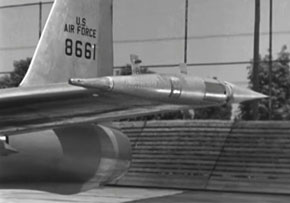  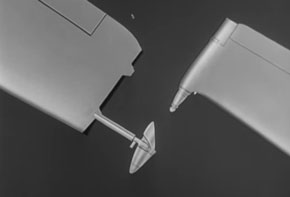 |
|
The B-29's range with two attached F-84s only decreased slightly. The project ended tragically, during a test of the automatic flight-control system, the F-84's nose collided with the B-29 upon connecting, shearing the fighter's nose and severely damaging the B-29's wing. Both aircraft crashed into Peconic Bay with no survivors.
|
|
PROJECT TOM TOM |
|
 |
Similar project as TIP TOW, but with a 10 engine aircraft the B-36 Peacemaker and F-84f Thunderstreak. Although several successful hookups were performed by Convair pilots turbulence and vortices continued to present a major problem. On 23 September 1956, RF-84F 51-1849, piloted by Beryl Erickson, was actually torn away from the right wing tip of the JRB-36F. All aircraft landed safely but the concept was deemed too dangerous, Project Tom-Tom was canceled.
|
PROJECT FICON (Fighter Conveyer) |
|
Earlier wingtip coupling experiments included Tip Tow and Tom-Tom followed the FICON project afterwards. The idea was that Fighter Conveyer (FICON) composite aircraft would perform long-range reconnaissance missions into areas equipped with anti-aircraft defenses that existing reconnaissance airplanes could not penetrate. FICON operations would rely on the great range of the Convair RB-36 to carry a jet powered parasite airplane to a location within range of targets inside defended territory. The high speed and maneuverability of the parasite would allow it to dash into enemy territory to take pictures of the targets and then rendezvous with its flying aircraft carrier to be carried back to its home base. In 1951, the Air Force awarded Convair a contract to modify one RB-36 for the FICON mission. The bomber had to be capable of carrying, launching and retrieving a fighter from its bomb bay. After a long sieries of tests the FICON system saw limited service with Strategic Air Command in 1955–56. The GRB-36D carriers from 99th Strategic Reconnaissance Wing (Fairchild AFB) operated in conjunction with RF-84K from 91st Strategic Reconnaissance Squadron (Larson AFB). |
|
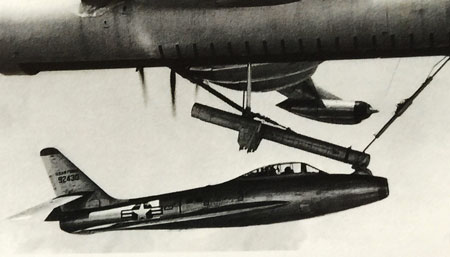 |
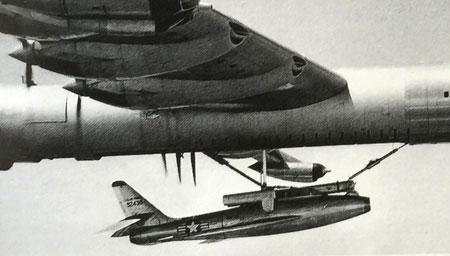 |
Subsequent test flights demonstrated the FICON concept was indeed "tactically sound", but its operational implementation was difficult. A total of 10 modified B-36 and 25 F-84F were modified and saw limited service in 1955–56. Hook ups with the carrier aircraft were challenging for the experienced test pilots under ideal conditions. In combat or in adverse weather, and by less-experienced pilots, they proved difficult, and several RF-84Ks were damaged attempting it. In addition, the RF-84 dramatically reduced the bomber's ground clearance: with 450 gallon (1,700 liter) external tanks on the fighter, the FICON combination cleared by a mere six inches (15 cm). These adversities, combined with the advent of reconnaissance platforms such as Lockheed's U-2 and the development of Boeing's B-52 Stratofortress and the KC-135 Stratotanker, which had the flying boom, eliminated the need for the FICON system, resulted in cancellation of the project in 1956. |
 |
SYSTEM ZELL (Zero Length Launch) and
|
|
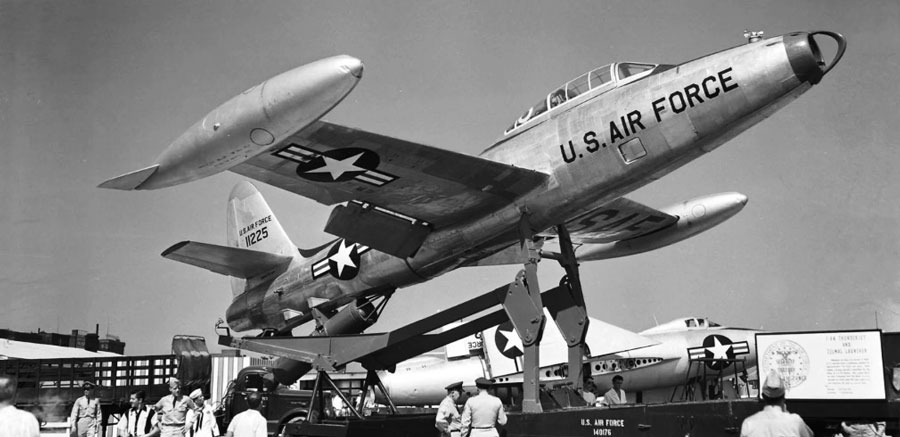 |
|
The objetive of a zero-length launch system is the elimination of the historic dependence on vulnerable airfields to facilitate air operations. The ZEro Length Launch system was a method whereby jet fighters nuclear armed and could be near-vertically launched using rocket motors to rapidly gain speed and altitude. The pilot had to withstand a greater acceleration than during an aircraft carrier launch, experiencing roughly 3.5 Gs. The rocket provided the F-84 with an additional 175 knots of airspeed. In the event of a sudden attack, air forces equipped with such systems could field effective air defenses and launch their own airstrikes even with their own airbases having been destroyed by an early nuclear attack. Although launching aircraft using rocket boosters proved to be relatively trouble-free, a runway was still required for these aircraft to be able to land or else be forced to crash. |
 |
The ZELMAL (Zero-length Launch Mat Landing) program investigated the possibility of a zero-length landing. The program was conducted 1953 and 1954. It involved a Republic F-84 aircraft and an inflatable rubber mat. The aircraft would perform a zero-length landing by catching an arrester cable with a tailhook, similar to an aircraft carrier landing. The aircraft would then drop onto the pneumatic rubber mat. A number of unmanned tests were performed before two piloted ZELMAL tests in 1954. In both cases the pilots suffered spinal injuries. The program was not continued after that. |
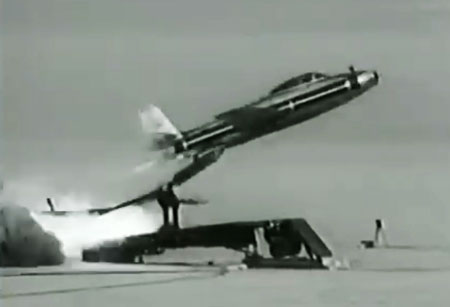 |
XF-84H THUNDERSCREECH |
|
 |
|
The turboprop-driven XF-84H (a joint Air Force/Navy project) was designed to combine the speed of jet aircraft with the long range, low fuel consumption, and low landing speed of propeller-driven aircraft. The XF-84H’s modified F-84F airframe included a T-tail and a triangular fin behind the cockpit to reduce the effect of torque from the propellers. Between July 1955 and October 1956, two XF-84Hs made 12 test flights -- Engine failures caused by the propeller's vibrations ended 10 of its 11 test flights due to mechanical issues with emergency landings. Although the XF-84H was one of the fastest single-engine, propeller-driven aircraft ever built, it never approached supersonic speed. Due to poor performance and high maintenance requirements, the XF-84H never became operational. |
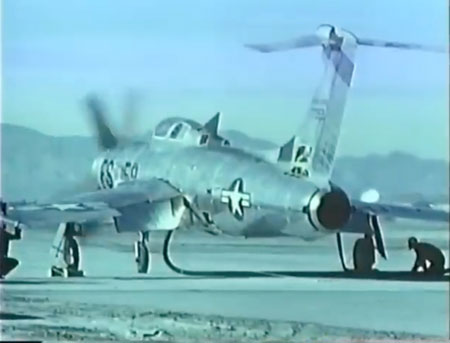 |
F-84 ground crews nicknamed the plane "Thunderscreech," a play on the nickname of the operation F-84 fighter bomber, because it was so loud. The propeller tips of the XF-84 traveled at Mach 1.18, faster than the speed of sound, producing 900 sonic booms per minute that could be heard some 25 miles away. The noise combined with the shock waves of the booms were enough to effectively cripple the area and any crewmen who might be in it. Crews would have to endure while the XF-84 was powering up for 30 minutes before takeof, some got sick from the noise. It´s the noisiest aircraft oh aviation history.
|
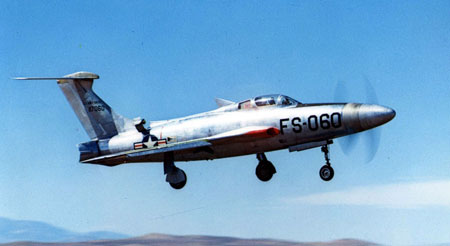 |
XF-91 THUNDERCEPTOR |
|
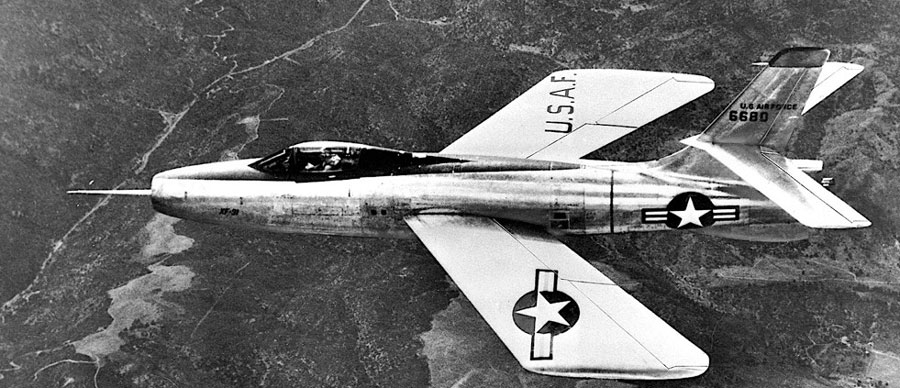 |
|
Thunderceptor was supposed to be a machine powered by a mixed propulsion system, capable of accelerating faster than sound toward its target. The prototype interceptor aircraft, developed by Republic Aviation, would use a General Electric afterburner jet engine capable of delivering 6,700 lbs. thrust, and a Reaction Motor rocket with four combustion chambers capable of boosting that by an extra 6,000 lbs. The firing of the two systems should have allowed the airplane to reach a top speed of 984 mph (1,584 kph), well beyond Mach 1. the four small rocket engines for added thrust during climb and interception.
Republic went for a swept wing design on their supersonic fighter concept, and such a configuration comes with dangers that, on account of the aerodynamics of the wing, especially at its tips, could send the aircraft tumbling in extreme cases. To fix that, engineers decided to make the wing surface increasingly larger as they moved toward the tips, a design called reverse tapered. Although effective in achieving the desired goal, it makes this plane one ugly-looking bird.
The design was largely obsolete by the time it was completed due to the rapidly increasing performance of contemporary jet engines, and only two prototypes were built.
One of these was the first American fighter to exceed Mach 1 in level flight.
Notice the 4 rockets at te engine exaust pipe. |
 |
 |
|
 |
|
GO TO - CLOCKS FOR SALE |
GO TOP OF THE PAGE |
HOME |